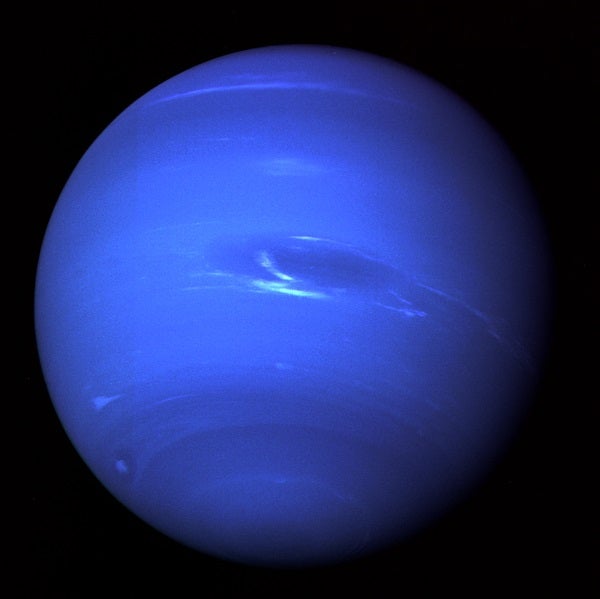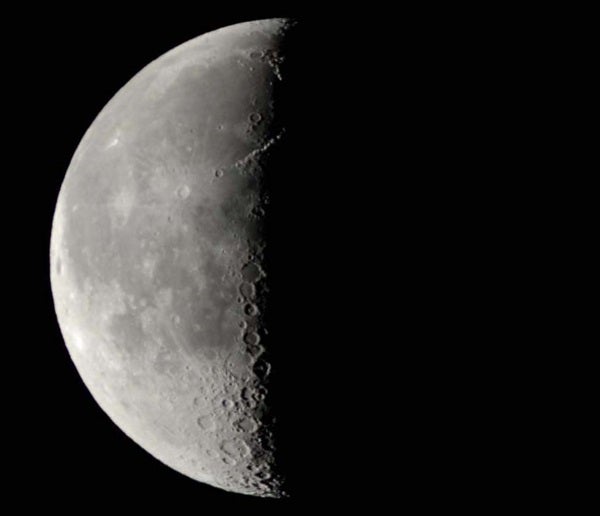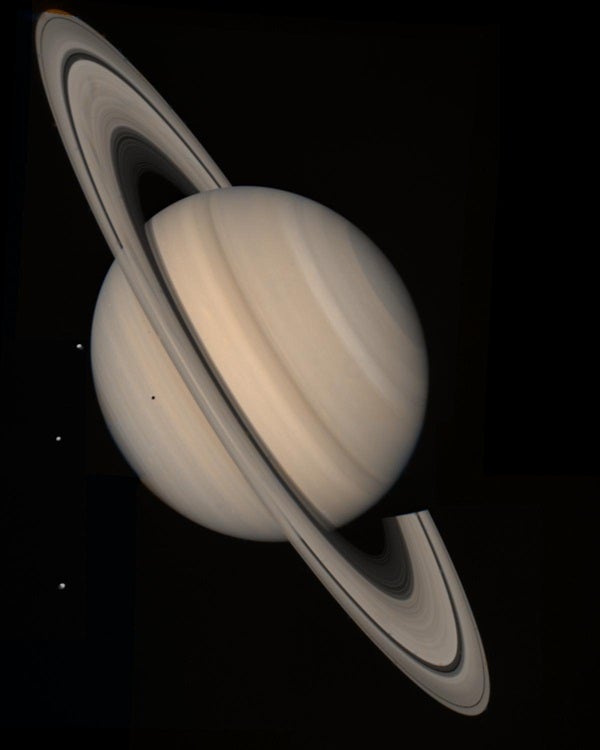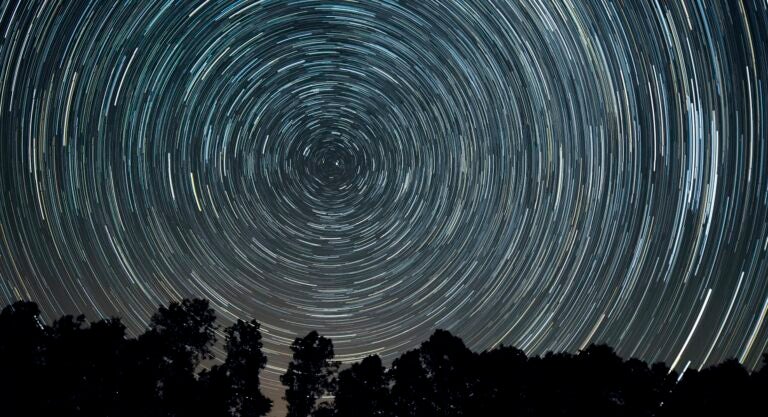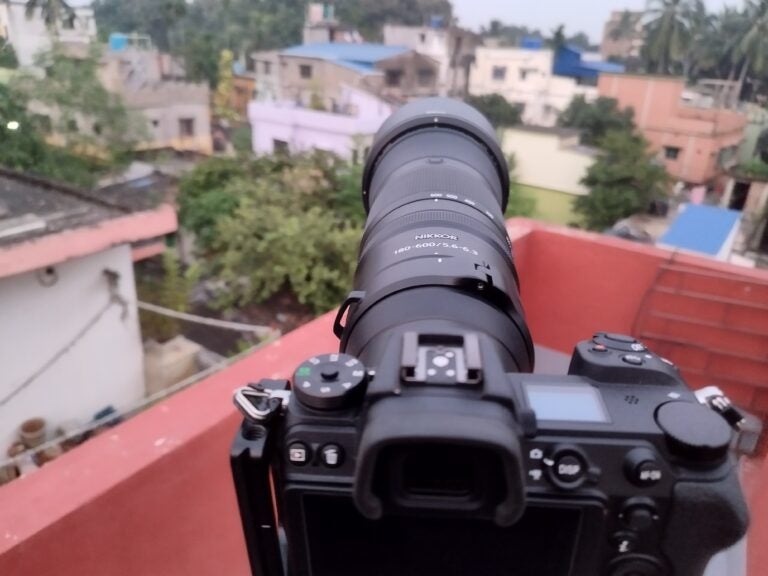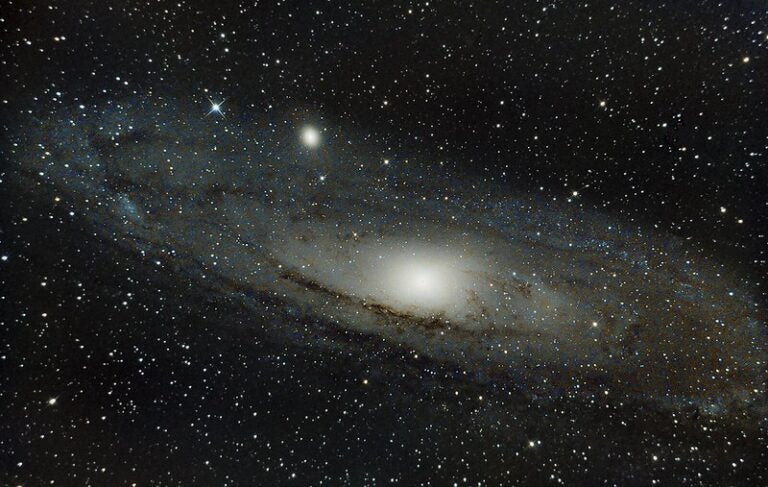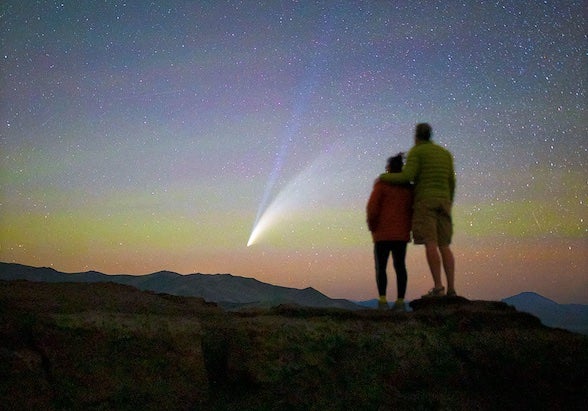Friday, July 22
- For observers across the eastern half of Canada and the United States (except along the Gulf Coast), the waning gibbous Moon crosses directly in front of Neptune tonight. The 8th-magnitude planet will be difficult to see even through a telescope when it passes behind the Moon’s lit limb, but significantly easier when it reappears from behind the dark limb. Because exact times depend on your specific location, set up your scope as soon as the two rise shortly after 10 p.m. local daylight time.
- The Big Dipper’s familiar shape appears halfway up the northwestern sky as darkness falls. One of the summer sky’s finest binocular double stars marks the bend of the Dipper’s handle. Mizar shines at 2nd magnitude, some six times brighter than its 4th-magnitude companion, Alcor. Even though these two are not physically related, they make a fine sight through binoculars. (People with good eyesight often can split the pair without optical aid.) A small telescope reveals Mizar itself as double — and these components do orbit each other.
Saturday, July 23
- Brilliant Jupiter remains a beacon in the western sky after sunset, though it’s not as high as it was earlier this summer. It appears nearly 15° high an hour after sunset and dips below the horizon around 10:30 p.m. local daylight time. Jupiter shines at magnitude –1.8 against the backdrop of southern Leo the Lion. The giant planet appears equally dazzling through a telescope, which reveals a wealth of atmospheric features on a disk that spans 33″.
Sunday, July 24
- If you didn’t have a chance to view Neptune passing behind the Moon on Friday, try tracking down the distant planet tonight when it passes 31′ (the width of a Full Moon) due south of the 4th-magnitude star Lambda (l) Aquarii. The pair rises soon after 10 p.m. local daylight time and climbs some 40° above the southern horizon by the start of morning twilight. You’ll need binoculars to spy magnitude 7.8 Neptune and a telescope to see its blue-gray disk, which spans 2.3″.
Monday, July 25
- Look toward the south-southwest as darkness falls and you can’t help but see Mars. The Red Planet shines brilliantly at magnitude –0.9 — trailing only Jupiter after dusk — against the much fainter background stars of Libra. And it remains visible until it dips below the southwestern horizon shortly after 1 a.m. local daylight time. When viewed through a telescope, Mars’ orange-red disk spans 14″ and shows a number of subtle dark markings.
Tuesday, July 26
- Last Quarter Moon occurs at 7:00 p.m. EDT. It doesn’t rise until nearly 1 a.m. local daylight time, however, by which time its phase has diminished almost imperceptibly to 46 percent lit. Earth’s only natural satellite appears against the relatively inconspicuous background stars of northeastern Cetus.
Wednesday, July 27
- Pluto reached opposition and peak visibility nearly three weeks ago, and it remains a tempting target all night. It glows dimly at magnitude 14.1, however, so you’ll need an 8-inch or larger telescope with good optics to spot it visually. Pluto currently lies in northeastern Sagittarius, some 0.8° west-southwest of 3rd-magnitude Pi (p) Sagittarii and 0.7° northeast of 4th-magnitude Omicron (o) Sgr. See “The quest for distant Pluto” in the July Astronomy for complete details on finding this world.
- The Moon reaches perigee, the closest point in its orbit around Earth, at 7:37 a.m. EDT. It then lies 229,698 miles (369,662 kilometers) away from us.
Thursday, July 28
- The Southern Delta Aquarid meteor shower reaches its peak overnight. Although the waning crescent Moon rises around 2 a.m. local daylight time tomorrow morning, it doesn’t really detract from the show. The meteors appear to radiate from the constellation Aquarius, which rises in late evening and appears highest in the hours before dawn. At its best, the shower produces 15 to 20 meteors per hour under a dark sky, a rate that stays nearly constant for a couple of days on either side of the peak.
Friday, July 29
- The Southern Delta Aquarid meteor shower isn’t the only event you’ll want to keep an eye on this morning. As the waning crescent Moon marches eastward relative to the background stars of Taurus, it passes directly in front of the Bull’s luminary. Our satellite occults 1st-magnitude Aldebaran for observers south of a line that runs from southern New Mexico to northern Maine. While viewers north of this line will see the Moon and star just miss each other, those along the line will witness the star skimming Luna’s northern limb. Be sure to set up ahead of time, center the star in your telescope’s field of view, and watch the magnificent show.
- Uranus’ eastward motion against the background stars comes to a halt at 10 p.m. EDT. This so-called stationary point marks the beginning of the best period to observe the outer planet. Uranus rises before midnight local daylight time and appears more than halfway to the zenith in the southeastern sky as morning twilight commences. The magnitude 5.8 planet lies in Pisces, 2.7° due north of magnitude 4.8 Mu (m) Piscium. A telescope reveals Uranus’ blue-green disk, which spans 3.6″.
Saturday, July 30
- Although Saturn reached its peak nearly two months ago, it remains a lovely sight. You can find the planet nearly due south around 9 p.m. local daylight time. Saturn shines at magnitude 0.3 and appears far brighter than any of the surrounding stars of southwestern Ophiuchus. When viewed through a telescope, the planet measures 18″ across while its dramatic ring system spans 40″ and tilts 26° to our line of sight.
Sunday, July 31
- The two inner planets lurk low in the western sky shortly after sunset all week. Your best chance to spot them comes when they lie highest in the twilight this evening. If you scan the western horizon through binoculars 30 minutes after sunset, you should pick up Venus standing just 3° high. It shows up only because in shines so brightly, at magnitude –3.9. Mercury appears 6° above the horizon but will be harder to see because it glows more dimly at magnitude –0.2. And if you have a haze-free sky, you might spot the 1st-magitude star Regulus between the two planets.

